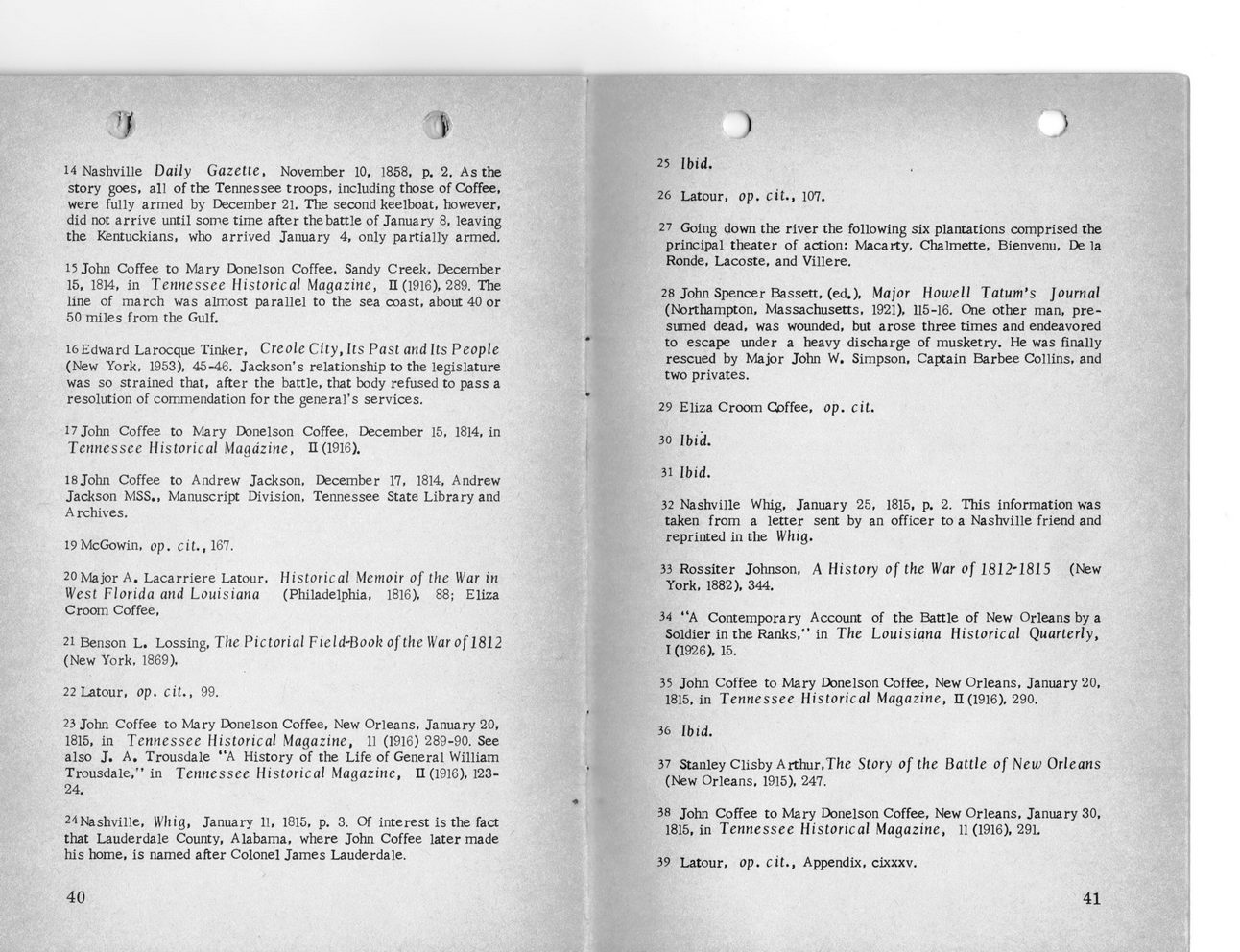This text was obtained via automated optical character recognition.
It has not been edited and may therefore contain several errors.
rf * 14 Nashville Daily Gazette, November 10, 1858, p. 2. As the story goes, all of the Tennessee troops, including those of Coffee, were fully armed by December 21. The second keelboat, however, did not arrive until some time after the battle of January 8, leaving the Kentuckians, who arrived January 4, only partially armed. 15 John Coffee to Mary Donelson Coffee, Sandy Creek, December 15, 1814, in Tennessee Historical Magazine, n (1916), 289. The line of march was almost parallel to the sea coast, about 40 or 50 miles from the Gulf. 16Edward Larocque Tinker, Creole City, Its Past and Its People (New York, 1953), 45-46. Jackson?s relationship to the legislature was so strained that, after the battle, that body refused to pass a resolution of commendation for the general?s services. 17 John Coffee to Mary Donelson Coffee, December 15, 1814, in Tennessee Historical Magazine, n (1916). l8john Coffee to Andrew Jackson, December 17, 1814, Andrew Jackson MSS., Manuscript Division, Tennessee State Library and Archives. 19McGowin, op. cit., 167. 20 Major A. Lacarriere Latour, Historical Memoir of the War in West Florida and Louisiana (Philadelphia, 1816), 88; Eliza Croom Coffee, 21 Benson L. Lossing, The Pictorial Field-Book of the War of 1812 (New York, 1869), 22 Latour, op, cit., 99. 23 John Coffee to Mary Donelson Coffee, New Orleans, January 20, 1815, in Tennessee Historical Magazine, 11 (1916) 289-90. See also J. A. Trousdale ?A History of the Life of General William Trousdale,? in Tennessee Historical Magazine, 11(1916), 123-24. 24Nashville, Whig, January 11, 1815, p. 3. Of interest is the fact that Lauderdale County, Alabama, where John Coffee later made his home, is named after Colonel James Lauderdale. 40 ) ) 25 Ibid. 26 Latour, op. cit., 107. 27 Going down the river the following six plantations comprised the principal theater of action: Macarty, Chalmette, Bienvenu, De la Ronde, Lacoste, and Villere. 28 John Spencer Bassett, (ed.), Major Howell Tatum's Journal (Northampton, Massachusetts, 1921), 115-16. One other man, presumed dead, was wounded, but arose three times and endeavored to escape under a heavy discharge of musketry. He was finally rescued by Major John W. Simpson, Captain Barbee Collins, and two privates. 29 Eliza Croom Coffee, op. cit. 30 Ibid. 31 Ibid. 32 Nashville Whig, January 25, 1815, p. 2. This information was taken from a letter sent by an officer to a Nashville friend and reprinted in the Whig. 33 Rossiter Johnson, A History of the War of 1812-1815 (New York, 1882), 344. 34 ?A Contemporary Account of the Battle of New Orleans by a Soldier in the Ranks,? in The Louisiana Historical Quarterly, I (1926), 15. 35 John Coffee to Mary Donelson Coffee, New Orleans, January 20, 1815, in Tennessee Historical Magazine, II (1916), 290. 36 Ibid. 37 Stanley Clisby Arthur,The Story of the Battle of New Orleans (New Orleans, 1915), 247. 38 John Coffee to Mary Donelson Coffee, New Orleans, January 30, 1815, in Tennessee Historical Magazine, 11(1916), 291. 39 Latour, op. cit,, Appendix, cixxxv. 41

Battle of 1814 41